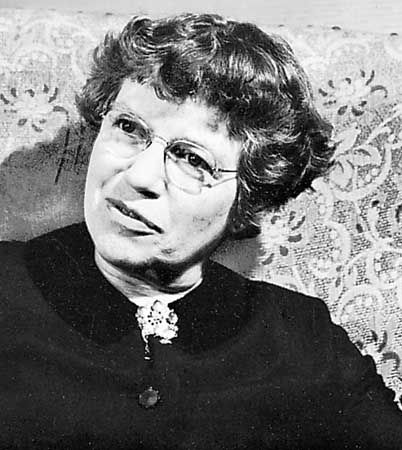Erik Erikson
- In full:
- Erik Homburger Erikson
- Also called:
- Erik H. Erikson
- Born:
- June 15, 1902, Frankfurt am Main, Germany
- Died:
- May 12, 1994, Harwich, Massachusetts, U.S. (aged 91)
- Awards And Honors:
- Pulitzer Prize
- Subjects Of Study:
- child development
- psychological development
- Oceti Sakowin
- Yurok
- culture
Erik Erikson (born June 15, 1902, Frankfurt am Main, Germany—died May 12, 1994, Harwich, Massachusetts, U.S.) was a German-born American psychoanalyst whose writings on social psychology, individual identity, and the interactions of psychology with history, politics, and culture influenced professional approaches to psychosocial problems and attracted much popular interest.
As a young man, Erikson attended art school and traveled around Europe. In 1927, when he was invited by the psychoanalyst Anna Freud to teach art, history, and geography at a small private school in Vienna, he entered psychoanalysis with her and underwent training to become a psychoanalyst himself. He became interested in the treatment of children and published his first paper in 1930, before completing psychoanalytic training and being elected to the Vienna Psychoanalytic Institute in 1933. The same year, he emigrated to the United States, where he practiced child psychoanalysis in Boston and joined the faculty of the Harvard Medical School. He became interested in studying the way the ego, or consciousness, operates creatively in sane, well-ordered individuals.
Erikson left Harvard in 1936 to join the Institute of Human Relations at Yale. Two years later he began his first studies of cultural influences on psychological development, working with Sioux Indian children at the Pine Ridge Reservation in South Dakota. These studies, and later work with the anthropologist Alfred Kroeber among the Yurok Indians of northern California, eventually contributed to Erikson’s theory that all societies develop institutions to accommodate personality development but that the typical solutions to similar problems arrived at by different societies are different.

Erikson moved his clinical practice to San Francisco in 1939 and became professor of psychology at the University of California, Berkeley, in 1942. During the 1940s he produced the essays that were collected in Childhood and Society (1950), the first major exposition of his views on psychosocial development. The evocative work was edited by his wife, Joan Serson Erikson. Erikson conceived eight stages of development, each confronting the individual with its own psychosocial demands, that continued into old age. Personality development, according to Erikson, takes place through a series of crises that must be overcome and internalized by the individual in preparation for the next developmental stage.
Refusing to sign a loyalty oath required by the University of California in 1950, Erikson resigned his post and that year joined the Austen Riggs Center in Stockbridge, Massachusetts. He then returned to Harvard as a lecturer and professor (1960–70) and professor emeritus (from 1970 until his death).
In Young Man Luther (1958), Erikson combined his interest in history and psychoanalytic theory to examine how Martin Luther was able to break with the existing religious establishment to create a new way of looking at the world. Gandhi’s Truth on the Origins of Militant Nonviolence (1969) also was a psychohistory. In the 1970s Erikson examined modern ethical and political problems, presenting his views in a collection of essays, Life History and the Historical Moment (1975), which links psychoanalysis to history, political science, philosophy, and theology. His later works include The Life Cycle Completed: A Review (1982) and Vital Involvement in Old Age (1986), written with his wife and Helen Q. Kivnik. A collection of papers, A Way of Looking at Things, edited by Stephen Schlein, appeared in 1987.









